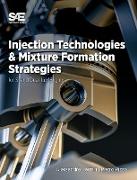- Start
- Injection Technologies and Mixture Formation Strategies For Spark-Ignition and Dual-Fuel Engines
Injection Technologies and Mixture Formation Strategies For Spark-Ignition and Dual-Fuel Engines
Angebote / Angebote:
Fuel injection systems and performance is fundamental to combustion engine performance in terms of power, noise, efficiency, and exhaust emissions. There is a move toward electric vehicles (EVs) to reduce carbon emissions, but this is unlikely to be a rapid transition, in part due to EV batteries: their size, cost, longevity, and charging capabilities as well as the scarcity of materials to produce them. Until these issues are resolved, refining the spark-ignited engine is necessary to address both sustainability and demand for affordable and reliable mobility. Even under policies oriented to smart sustainable mobility, spark-ignited engines remain strategic, because they can be applied to hybridized EVs or can be fueled with gasoline blended with bioethanol or bio-butanol to drastically reduce particulate matter emissions of direct injection engines in addition to lower CO2 emissions.
In this book, Alessandro Ferrari and Pietro Pizzo provide a full review of spark-ignited engine fuel injection systems. The most popular typologies of fuel injection systems are considered, with special focus on state-of-the-art solutions. Dedicated sections on the methods for air mass evaluation, fuel delivery low-pressure modules, and the specific subsystems for idle, cold start, and warm-up control are also included. The authors pay special attention to mixture formation strategies, as they are a fundamental theme for SI engines. An exhaustive overview of fuel injection technologies is provided, and mixture formation strategies for spark ignited combustion engines are considered. Fuel Injection Systems illustrates the performance of these systems and will also serve as a reference for engineers who are active in the aftermarket, offering detailed information on fuel injection system solutions that are mounted in older vehicles.
Folgt in ca. 15 Arbeitstagen




